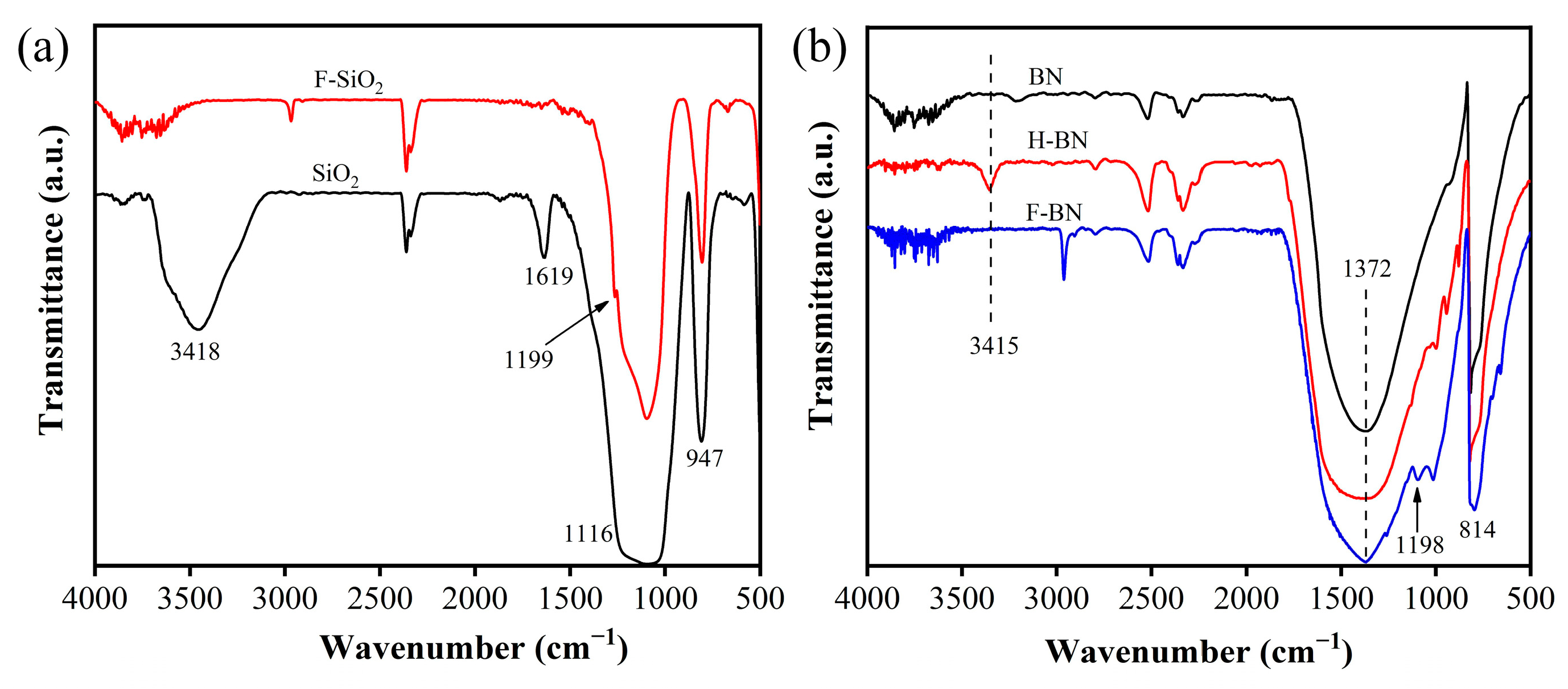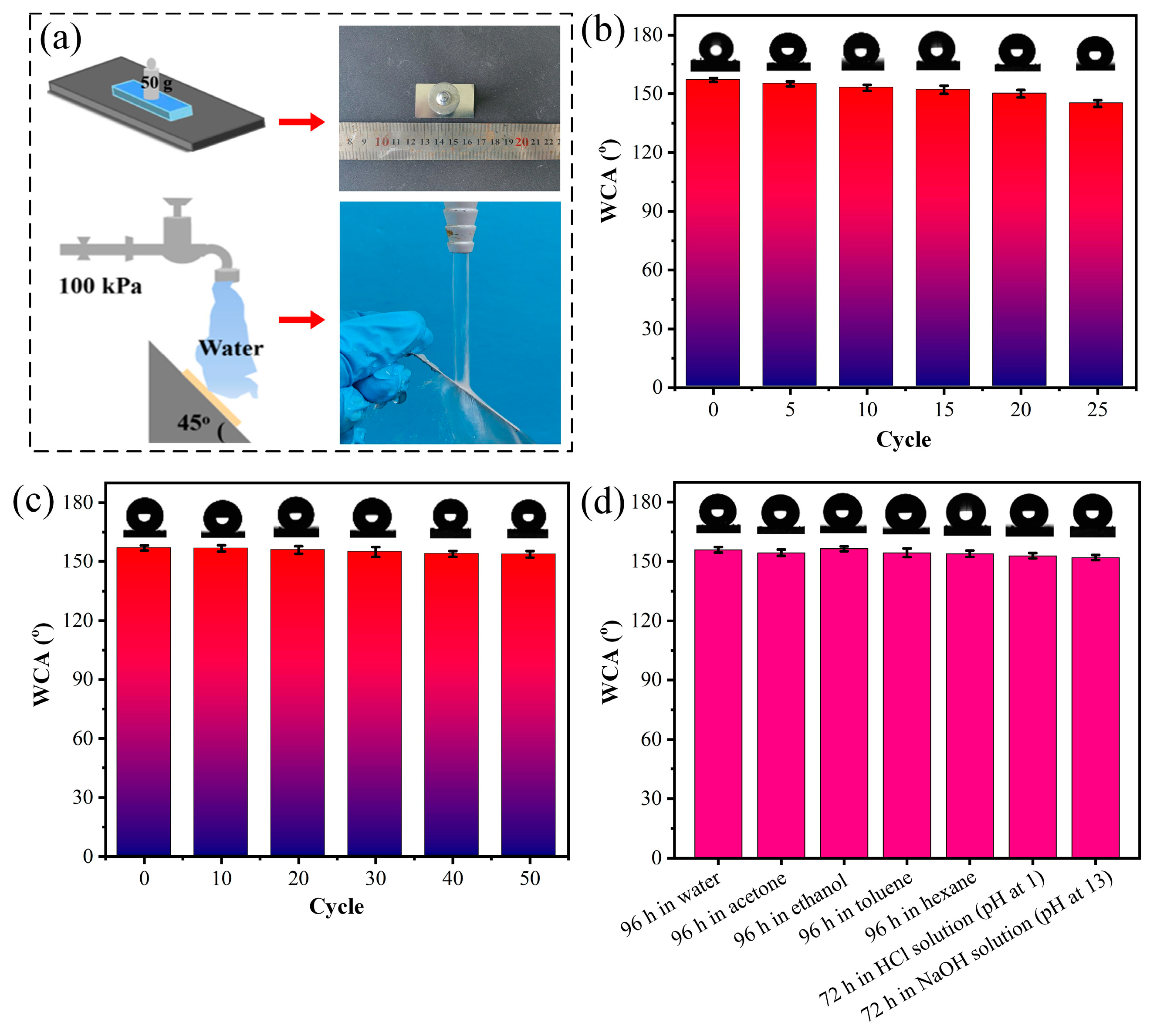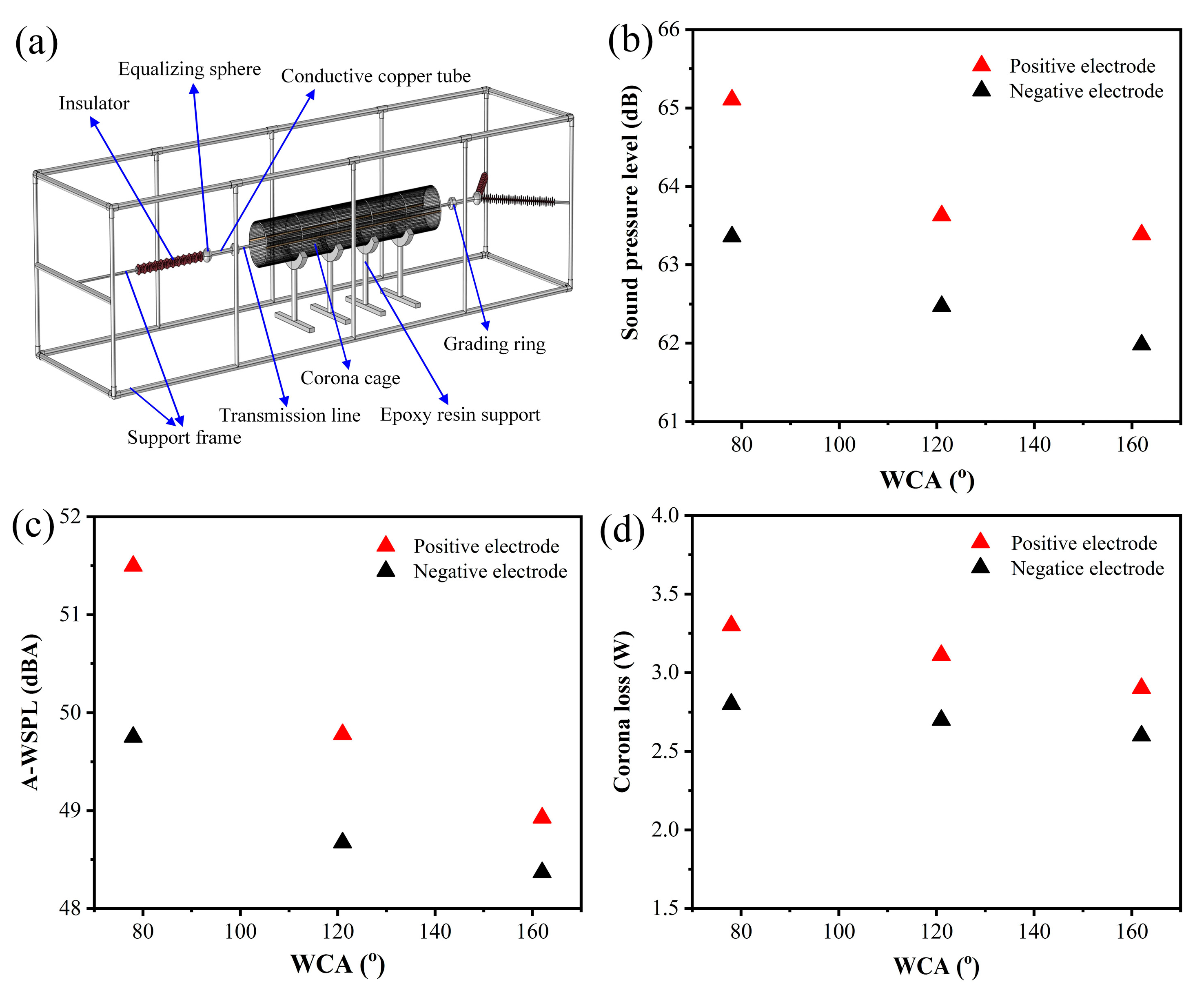Superhydrophobic and Thermally Conductive Coating for Restraining Corona Loss and Audible Noise of High-Voltage Transmission Lines
Abstract
:1. Introduction
2. Materials and Methods
2.1. Materials
2.2. Preparation of Fluorinated Silica (F-SiO2) Particles
2.3. Preparation of Fluorinated BN (F-BN) Powders
2.4. Preparation of V-PDMS/F-BN/F-SiO2 Composite Coating
2.5. Evaluation of Adhesion, Mechanical Strength, and Chemical Stability
2.6. Measurement of Corona Noise of High-Voltage Transmission Line
2.7. Characterizations
3. Results and Discussion
3.1. Chemical Characterization of F-SiO2 and F-BN
3.2. Surface Morphology and Wettability of V-PDMS/F-BN/F-SiO2 Composite Coating
3.3. Adhesion, Mechanical Stability, and Chemical Stability of V-PDMS/F-BN/F-SiO2 Composite Coating
3.4. Thermal Conductivity of V-PDMS/F-BN/F-SiO2 Composite Coating
3.5. Corona Characteristics of V-PDMS/F-BN/F-SiO2 Composite Coating on High-Voltage Transmission Line
4. Conclusions
Author Contributions
Funding
Institutional Review Board Statement
Informed Consent Statement
Data Availability Statement
Conflicts of Interest
References
- He, W.; Wan, B.; Liu, Y.; Liu, X.; Huang, S.; Zhang, Y.; Zhang, J. Audible noise spectral characteristics of high-voltage AC bundled conductors at high altitude. IET Gener. Transm. Distrib. 2021, 15, 1304–1313. [Google Scholar] [CrossRef]
- Zhang, Z.; Pang, G.; Lu, M.; Gao, C.; Jiang, X. Study on decay-like fracture of 500 kV composite insulators: Infrared, ultraviolet and electric field distribution detection. IET Gener. Transm. Distrib. 2022, 16, 4132–4141. [Google Scholar] [CrossRef]
- Sun, Q.; Li, X.; Liu, X.; Lv, F.; Lv, J.; Du, P. Research on evaluation method for first-class city distribution network. Guangdong Electr. Power 2020, 30, 26–34. (In Chinese) [Google Scholar] [CrossRef]
- Zhao, L.; Lu, J.; Xie, L.; Cui, X.; Ju, Y. Study on the effect of altitude on the corona inception field and the ground-level total electric field under HVDC lines using bipolar test lines. IEEE Trans. Power Deliver. 2018, 33, 3187–3195. [Google Scholar] [CrossRef]
- Liu, Y.; Guo, J.; Lu, J. Audible noise spectrum characteristics of UHVDC positive line using corona cage. High Volt. Eng. 2013, 39, 1324–1330. [Google Scholar]
- Liu, B.; Yuan, W. Analysis on relevance of surface discharge strength to aging and pollution of glass insulators. Guangdong Electr. Power 2023, 36, 102–110. (In Chinese) [Google Scholar]
- Yin, F.; Farzaneh, M.; Jiang, X. Corona investigation of an energized conductor under various weather conditions. IEEE Trans. Dielect. Electr. Insul. 2017, 24, 462–470. [Google Scholar] [CrossRef]
- Yi, Y.; Wang, L. Conductor surface conditions effects on audible noise spectrum characteristics of positive corona discharge. IEEE Trans. Dielect. Electr. Insul. 2016, 23, 1872–1878. [Google Scholar] [CrossRef]
- Taylor, E.R.; Chartier, V.L.; Rice, D.N. Audible noise and visual corona from HV and EHV transmission lines and substation conductors-laboratory tests. IEEE Trans. Power Appar. Syst. 1969, 88, 666–679. [Google Scholar] [CrossRef]
- Al-geelani, N.A.; Piah, M.A.M.; Abdul-Malek, Z. Identification of acoustic signals of corona discharges under different contamination levels using wavelet transform. Electr. Eng. 2018, 100, 1059–1067. [Google Scholar] [CrossRef]
- He, G.; Hu, Q.; Shu, L.; Jiang, X.; Yang, H.; Yang, D.; Sundararajan, R. Impact of icing severity on positive corona generated audible noise characteristic of rime ice-covered conductor. IEEE Trans. Ind. Appl. 2019, 55, 5269–5276. [Google Scholar] [CrossRef]
- Hu, Q.; He, G.; Shu, L.; Jiang, X.; Yang, H.; Tan, J. Influence of voltage polarity on the corona performance of ice-covered conductor. Int. J. Electr. Power Energy Syst. 2019, 105, 123–130. [Google Scholar] [CrossRef]
- Bies, D.A.; Hansen, C.H. Engineering Noise Control: Theory and Practice, 3rd ed.; Spon Press: New York, NY, USA, 2009; pp. 174–275. [Google Scholar]
- Li, Q.; Rowland, S.M.; Dupere, I.; Shuttleworth, R. Acoustic noise evaluation for overhead line conductors using an anechoic chamber. IEEE Trans. Power Deliver. 2017, 32, 1835–1843. [Google Scholar] [CrossRef]
- Vinh, T.; King, J.V. Statistical analyses of audible noise and corona loss for a 10-conductor UHV bundle. IEEE Trans. Power Deliver. 1987, 2, 217–224. [Google Scholar] [CrossRef]
- Pokorny, W.C.; Schlomann, R.H. Investigation of corona effects from wet bundle conductors for application to UHV configurations. IEEE Trans. Power Appar. Syst. 1972, 29, 211–222. [Google Scholar] [CrossRef]
- Anderson, J.G.; Zaffanella, L.E. Project UHV test line research on the corona performance of a bundle conductor at 1000 kV. IEEE Trans. Power Appar. Syst. 1972, 29, 223–232. [Google Scholar] [CrossRef]
- Wang, Q.; Kundur, D.; Yuan, H.; Liu, Y.; Lu, J.; Ma, Z. Noise suppression of corona current measurement from HVDC transmission lines. IEEE Trans. Instrum. Meas. 2016, 65, 264–275. [Google Scholar] [CrossRef]
- Zhao, L.; Lu, J.; Cui, X.; Xie, L.; He, K. The altitude effect and correction of audible noise for HVDC transmission lines. IEEE Trans. Power Deliver. 2017, 32, 1954–1963. [Google Scholar] [CrossRef]
- Bian, X.; Chen, L.; Yu, D.; MacAlpine, J.M.K.; Wang, L.; Guan, Z.; Chen, F.; Yao, W.; Zhao, S. Influence of aged conductor surface conditions on AC corona-generated audible noise with a corona cage. IEEE Trans. Dielect. Electr. Insul. 2012, 19, 2037–2043. [Google Scholar] [CrossRef]
- Mizutani, T.; Ieda, M. TSC from corona-charged high-density polyethylene and the effects of oxidation. J Phys. D 1978, 11, 185–191. [Google Scholar] [CrossRef]
- Wen, G.; Guo, Z.; Liu, W. Biomimetic polymeric superhydrophobic surfaces and nanostructures: From fabrication to applications. Nanoscale 2017, 9, 3338–3366. [Google Scholar] [CrossRef] [PubMed]
- Xia, C.; Hu, C.; Jin, Z. Preparation and property study of air-dryable superhydrophobic silica coatings. Paint Coat. Ind. 2023, 53, 30–36. (In Chinese) [Google Scholar]
- Su, X.; Li, H.; Lai, X.; Chen, Z.; Zeng, X. 3D porous superhydrophobic CNT/EVA composites for recoverable shape reconfiguration and underwater vibration detection. Adv. Funct. Mater. 2019, 29, 1900554. [Google Scholar] [CrossRef]
- Zheng, L.; Li, H.; Lai, X.; Huang, W.; Lin, Z.; Zeng, X. Superwettable Janus nylon membrane for multifunctional emulsion separation. J. Membrane Sci. 2022, 642, 119995. [Google Scholar] [CrossRef]
- Du, Y.; Hu, L.; Dong, L.; Du, S.; Xu, D. Experimental study on anti-icing of robust TiO2/polyurea superhydrophobic coating. Coatings 2023, 13, 1162. [Google Scholar] [CrossRef]
- Li, L.; Ma, Y.; Fang, L.; Lu, C.; Xu, Z. Preparation and study of fiber coatings with both self-cleaning and self-healing functionalities. Paint Coat. Ind. 2022, 52, 7–13. (In Chinese) [Google Scholar]
- Su, X.; Li, H.; Lai, X.; Zhang, L.; Wang, J.; Liao, X.; Zeng, X. Vapor-liquid sol-gel approach to fabricating highly durable and robust superhydrophobic polydimethylsiloxane@silica surface on polyester textile for oil-water separation. ACS Appl. Mater. Interfaces 2017, 9, 28089–28099. [Google Scholar] [CrossRef]
- Shu, L.; Wu, Z.; He, Y.; Yuan, W.; Hu, Q. The influence of DC electrical field on composite insulators icing and leakage current characteristics. In Proceedings of the 2013 IEEE Conference on Electrical Insulation and Dielectric Phenomena, Shenzhen, China, 20–23 October 2013. [Google Scholar]
- Su, J.; Orive, A.G.; Grundmeier, G. Nano-FTIR and chemical force analysis of electrografted aryldiazonium salts on ODT-microcontact printed Au-surfaces. Appl. Surf. Sci. 2023, 609, 155355. [Google Scholar] [CrossRef]
- Hu, Q.; Lv, A.; Ma, Y.; Wang, Y.; Zhang, H.; Mi, X.; Xiao, Q. In situ polymerization to boron nitride-fluorinated poly methacrylate composites as thin but robust anti-corrosion coatings. Coatings 2021, 11, 1518. [Google Scholar] [CrossRef]
- Wu, J.; Li, H.; Lai, X.; Chen, Z.; Zeng, X. Conductive and superhydrophobic F-rGO@CNTs/chitosan aerogel for piezoresistive pressure sensor. Chem. Eng. J. 2020, 386, 123998. [Google Scholar] [CrossRef]
- Lee, J.; Yong, K. Surface chemistry controlled superhydrophobic stability of W18O49 nanowire arrays submerged underwater. J. Mater. Chem. 2012, 22, 20250–20256. [Google Scholar] [CrossRef]
- Chen, B.; Li, H.; Zhang, S.; Lai, X.; Zeng, X.; Wu, X.; Cheng, X.; Liu, H. High-performance and superhydrophobic piezoresistive pressure sensor based on mountain ridge-like microstructure by silver nanoparticles and reduced graphene oxide. Compos. Part A Appl. Sci. Manuf. 2022, 162, 107171. [Google Scholar] [CrossRef]







Disclaimer/Publisher’s Note: The statements, opinions and data contained in all publications are solely those of the individual author(s) and contributor(s) and not of MDPI and/or the editor(s). MDPI and/or the editor(s) disclaim responsibility for any injury to people or property resulting from any ideas, methods, instructions or products referred to in the content. |
© 2023 by the authors. Licensee MDPI, Basel, Switzerland. This article is an open access article distributed under the terms and conditions of the Creative Commons Attribution (CC BY) license (https://creativecommons.org/licenses/by/4.0/).
Share and Cite
Li, L.; Xu, J.; Wang, Y.; Meng, W.; Fan, S.; Li, H. Superhydrophobic and Thermally Conductive Coating for Restraining Corona Loss and Audible Noise of High-Voltage Transmission Lines. Coatings 2023, 13, 1530. https://doi.org/10.3390/coatings13091530
Li L, Xu J, Wang Y, Meng W, Fan S, Li H. Superhydrophobic and Thermally Conductive Coating for Restraining Corona Loss and Audible Noise of High-Voltage Transmission Lines. Coatings. 2023; 13(9):1530. https://doi.org/10.3390/coatings13091530
Chicago/Turabian StyleLi, Li, Junhuang Xu, Yifan Wang, Wei Meng, Shengping Fan, and Hongqiang Li. 2023. "Superhydrophobic and Thermally Conductive Coating for Restraining Corona Loss and Audible Noise of High-Voltage Transmission Lines" Coatings 13, no. 9: 1530. https://doi.org/10.3390/coatings13091530




